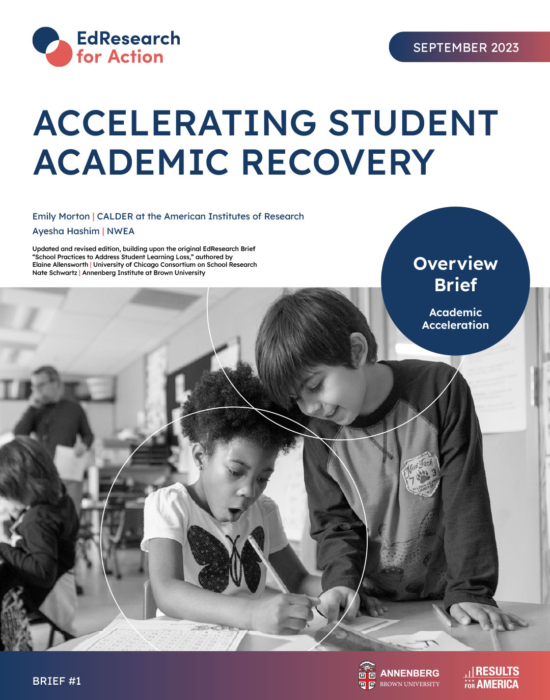PREPARING SCHOOLS TO MEET THE NEEDS OF STUDENTS COPING WITH TRAUMA AND TOXIC STRESS
This brief is one in a series aimed at providing K-12 education decision makers and advocates with an evidence base to ground discussions about how to best serve students during and following the novel coronavirus pandemic.
Micere Keels | The University of Chicago
Sonya Dinizulu | The University of Chicago
Shipra Parikh | The University of Chicago
Tynisha Jointer | Invested Consultant Firm
May 2021 | Brief No. 17
Central Question
What policies, procedures, and practices coupled with professional development can prepare schools to meet the needs of students coping with trauma and toxic levels of stress?
Key Insights
Breaking Down the Issue
- Trauma disrupts the development of core cognitive, social, emotional, and behavioral competencies that are needed to succeed in school.
- Trauma is broadly experienced across the U.S. student population, but disproportionately concentrated among members of racially and ethnically marginalized and lower-income communities.
- The pandemic has placed increased pressure on schools to provide mental health support, especially for schools serving racially and ethnically marginalized students, and those living in lower-income communities.
- Many teachers and staff members report that they need more training in recognizing and responding to student trauma.
Strategies to Consider
- Investments in staff mental health can improve outcomes for both students and staff members.
- Whole-school (Tier 1) strategies for addressing trauma tend to be more effective than strategies that focus only on identifying individual students for secondary intervention.
- A limited set of school-based trauma-focused Tier 2 interventions have demonstrated effectiveness in helping children and youth recover from traumatic experiences.
- Schools can increase their capacity to meet the needs of students coping with trauma by creating a school-wide plan that includes all staff, in addition to family and community stakeholders.
Strategies to Avoid
- Plans that place the burden for supporting students on clinical staff, such as school social workers and counselors, are unlikely to be effective.
- One-shot awareness- building professional development that doesn’t connect to strategies for how educators can respond to students’ needs are unlikely to lead to improved student outcomes.
Although there is a substantial research base on the science of trauma and its effects on children, many of the strategies for translating this knowledge into the daily work of schools are still being developed and evaluated. Therefore, the evidence in this brief includes a mix of findings from extant studies and learnings from expert researchers and practitioners who are actively working to implement practices in schools.
Breaking Down The Issue
Trauma disrupts the development of core cognitive, social, emotional, and behavioral competencies that are needed to succeed in school.
Unaddressed trauma can show up as internalizing and externalizing behaviors. The externalizing behaviors can often show up as challenging behavior in school.
- Trauma refers to the psychological, emotional, and spiritual wounds that are created by one or more events that overwhelm a person’s abilities to cope.
- Students experiencing trauma often externalize their feelings of distress into oppositional behaviors that can be challenging for educators. These include aggression, defiance, attachment disruptions, relational mistrust, and emotional dysregulation. Challenging student behaviors escalate when responded to with punitive and exclusionary discipline.
- Students experiencing trauma can also internalize their feelings of distress into behavior that often goes unnoticed and unaddressed in the classroom. Some of these behaviors include lack of engagement, anxiousness, and somatic complaints (excess focus on unexplained physical symptoms).
Unaddressed trauma diminishes students’ abilities to benefit from rigorous instruction because they are less likely to be in their “learning brain,” a regulated neurobiological state that facilitates the processing and encoding of information.
- The brain science of trauma informs us that chronic activation of the brain’s stress response reduces capacities of memory consolidation, concentration, sustained attention, and retaining or recalling information.
- Greater awareness of the common behavioral responses to trauma can minimize over-diagnosis of pathologizing and stigmatizing conditions, such as learning disabilities, attention-deficit/hyperactivity disorder, emotional disturbance disorders, and oppositional defiant disorders.
Trauma is broadly experienced across the U.S. student population, but disproportionately concentrated among members of racially and ethnically marginalized and lower-income communities.
Approximately 25% of school-aged children overall and 80% of children in high-poverty, high-crime neighborhoods have experienced at least one traumatic event that can profoundly affect child development.
- Large sociodemographic disparities in exposure to community violence and other traumatic stressors place subgroups of students at differential risk for school failure, and in turn, increased risk of criminal justice system involvement.
Research from previous disasters informs us to expect that serious mental health challenges will be exhibited by as many as one in three children who are in families that were directly affected by the COVID-19 virus and by the negative economic effects of the pandemic.
- The direct loss of caregivers to the virus, parental distress due to sudden and devastating job loss, and overall increased stress among adults in the household can contribute to child mental health challenges.
- The National Association of School Psychologists estimates that the COVID-19 pandemic will result in an overall doubling or tripling of students who exhibit social, emotional, and behavioral challenges at school.
- Strong evidence shows there is racial disproportionality in the likelihood that remote learning will be associated with increased exposure to adverse home and community contexts that increase psychological, emotional, and behavioral dysregulation.
The pandemic has placed increased pressure on schools to provide mental health support, especially for schools serving racially and ethnically marginalized students, and those living in lower-income communities.
70% of children who receive mental health services receive care in a school setting.
- Only 16% of all American children receive any mental health services, and of those receiving care, over 70% receive that care in a school setting.
- Even prior to the COVID-19 pandemic, schools had limited capacity to meet children’s needs for mental health care. The overwhelming majority of children in need of care do not receive services; this is especially true of children in low-income households.
The pandemic is exacerbating already large disparities in the presence of mental health challenges and access to coping and recovery services.
- SAMHSA’s report on COVID-19 and Behavioral Health Disparities for Black and Latino Communities in the U.S. highlights important differences in need and access across these groups. Indigenous/Native American communities are also disproportionately affected by the pandemic; addressing inequalities in school-based resources is necessary for mitigating vulnerability to COVID-19.
- Research from Hurricane Katrina and other disasters showed that mental health challenges were higher among racial and ethnic minority youth because their families were the most affected while having the least access to support.
Many teachers and staff members report that they need more training in recognizing and responding to student trauma.
Researchers found that even before the pandemic, most educators felt unprepared to meet the social and emotional needs of children coping with trauma.
- Classroom teachers reported needing training on how trauma affects students, and training that would help them define their roles in relation to students’ academic, behavioral, and social and emotional needs.
- Studies show that many educators also perceive a false dichotomy between meeting students’ social and emotional learning needs versus their academic needs.
- Research shows that staff struggle to support students coping with trauma and stress if they themselves are experiencing poor mental health.
Strategies to Consider
Investments in staff mental health can improve outcomes for both students and staff members.
Several studies have found that districts and schools that invested in staff mental health in the aftermath of natural disasters had better outcomes for staff and students when compared to those that did not attend to staff needs.
- A small but growing number of studies show that pre-service and in-service training programs that combine mindfulness, compassion, and implicit bias reduction can improve outcomes for educators and students.
- There is substantial evidence that the benefits of investing in professional development to help educators manage professional stress far outweigh the costs of recruiting and training new teachers in the event that teachers leave the profession.
Improving staff knowledge of compassion fatigue and secondary trauma, and providing institutionalized resources to assist with prevention, management, and mitigation of symptoms, can significantly shift student and educator outcomes.
- For example, CARE for Teachers is a professional development program that introduces an evidence-based set of strategies to help teachers develop skills, including relaxation and emotion awareness. This program has been evaluated in several randomized trials and resulted in significant improvements in well-being and efficacy for both teachers and students.
- Some researchers recommend a dual framework that simultaneously addresses the needs of students coping with trauma and the needs of staff who are at-risk for and already negatively impacted by secondary traumatic stress and associated conditions.
Whole-school (Tier 1) strategies for addressing trauma tend to be more effective than strategies that focus only on identifying individual students for secondary intervention.
Students spend the overwhelming majority of their time in classroom spaces; stressful and competitive classroom climates can undermine gains made in Tier 2 and Tier 3 interventions.
- Studies suggest that students are more likely to experience positive classroom climates and receive emotional support from classroom teachers who have higher levels of mindfulness, self-compassion, self-efficacy, and positive emotions.
- Multi-tiered systems, the foundation on which trauma-responsive school models are built, depend on continued data analysis to match students’ needs to evidence-based interventions, and to determine whether preventive practices are effective.
- Teachers can use trauma-responsive strategies that are based in a neurobiological understanding of how trauma affects cognitive, emotional, and behavioral functioning.
Whole-school social and emotional learning strategies can offer important counterbalances to the ways in which trauma undermines students’ development of self-regulation and interpersonal skills.
- Integrating social and emotional learning into core courses rather than standalone lessons leads to the largest gains in development of social-emotional competencies.
- Positive Behavioral Intervention and Supports (PBIS), a problem-solving framework to improve outcomes for all students, has been shown to be effective in fostering a culture of safety and belonging for the entire school community.
Investments in staff-student relationships are critical because of the ways that trauma disrupts students’ abilities to build interpersonal relationships and the central role of teacher-student relationships in learning.
- Implicit bias training has been shown to decrease the harsh discipline outcomes for racial and ethnic minority children.
- Relationships with stable, caring adults have been shown to mitigate the developmental risks associated with poverty. The Educated Edge trains school personnel at all levels in communication strategies that foster relational learning environments through community building and addressing the social determinants of health.
- Creating a collaborative classroom can reduce the stress and anxiety that can be triggered by academic competition.
A limited set of school-based trauma-focused Tier 2 interventions have demonstrated effectiveness in helping children and youth recover from traumatic experiences.
The following Tier 2 and Tier 3 interventions have demonstrated effectiveness for children and youth who have experienced chronic or acute trauma and/or toxic levels of stress:
- Bounce Back targets students in K through 5th grade, and focuses on developing coping skills and empowering young people to share their trauma narrative with peers and family.
- Cognitive–Behavioral Intervention for Trauma in Schools (CBITS) targets students in 5th through 12th grade and is designed to reduce symptoms of psychological and behavioral distress and improve attendance and academic outcomes. It has also been adapted to serve a culturally diverse range of students.
- Structured Psychotherapy for Adolescents Responding to Chronic Stress (SPARCS) targets students in 6th through 12th grade and is designed to help students regulate emotions and behaviors, manage impulses, maintain healthy relationships, build executive functioning skills, and manage physical complaints.
- Trauma-Focused Cognitive Behavioral Therapy (TF-CBT) for students receiving Tier 3 support has shown a high level of efficacy in healing a broad range of emotional and behavioral difficulties associated with single, multiple, and complex trauma experiences.
Tier 2 interventions are most beneficial when data and screenings are used to match students with appropriate supports.
- Behavioral health/care teams have been shown to be an important part of facilitating effective and equitable matching to Tier 2 services.
- This teaming structure should effectively identify criteria for referral as well as include diverse members of the student body.
- When faced with limited teaming capacity, the problem-solving process should be prioritized.
Schools can increase their capacity to meet the needs of students coping with trauma by creating a school-wide plan that includes all staff, in addition to family and community stakeholders.
A team approach can support school staff to meet challenges more effectively and efficiently as well as ensure that behavioral and mental health supports are delivered to students in a coordinated and transparent manner.
- Principals and other administrators can create and implement school-wide policies and develop schedules that enable staff to access structural trauma-responsive support.
- Teachers can implement trauma-informed classroom strategies to support neurobiological regulation, which significantly reduces the student dysregulation that frequently disrupts instruction when it is externalized, or goes unnoticed when it is internalized.
- Social workers and counselors can develop universal screening plans to proactively identify trauma symptoms and triggers in students and provide Tier 2 and Tier 3 interventions.
- School nurses can be trained and empowered to focus on more than the physical health of students. For example, the Trauma Responsive Educational Practices (TREP) Project partnered with Chicago Public Schools to develop this mental health and trauma-focused professional development course for school nurses.
- Security staff can be trained in de-escalation strategies that are responsive to the needs of students coping with trauma.
School-based supports are likely to be more effective and culturally responsive when students have a voice in decision-making. Giving students a voice in school decision-making is beneficial for their social development and educational outcomes and may lead to an improvement in school climate.
- Youth-led restorative practices can build community and improve discipline through participatory learning and decision-making.
- Understanding how students have been affected by COVID-19 will be key to helping them restore and recover a sense of trust and safety in school.
Parent engagement has been shown to improve student school engagement, performance, and learning.
- Engagement is more than prescribing how parents can contribute to the school, it also includes listening to and understanding their concerns, which will be critical for helping schools and students recover from COVID- 19-related trauma.
- Toolkits have been developed to aid schools in the process of engaging families in efforts to support students coping with trauma.
Community-based organizations are critical for building the capacity needed to sustainably meet students’ mental health needs which leads to improved educational outcomes.
- Mental health professionals, nurses, child welfare workers, and youth development nonprofits can be located inside schools to offer one-stop education and health service delivery
Strategies to Avoid
Plans that place the burden for supporting students on clinical staff, such as school social workers and counselors, are unlikely to be effective.
Pull-out interventions focused on developing social skills don’t result in sustained learning unless they are coupled with practice and reinforcement in the classroom and other school spaces.
Social workers and counselors can be more effective by working with teachers to make their classrooms more developmentally supportive, rather than relying on pulling out individual students.
- Students spend the majority of their time with classroom teachers, and reliance on pull-out interventions comes with the cost of loss of instructional time.
- Additionally, multidisciplinary teaming increases collaboration and communication across staff roles in ways that improve school culture and climate.
One-shot awareness-building professional development that doesn’t connect to strategies for how educators can respond to students’ needs is unlikely to lead to improved student outcomes.
Effective professional development requires applied, pragmatic, and case-based learning for staff to learn and implement problem-solving strategies.
Professional development programming must be ongoing in order to improve teacher confidence and preparation, and it must address staff experiences of trauma in their own lives in order for them to address it professionally in their work with students.



Funding for this research was provided by the Bill & Melinda Gates Foundation. The findings and conclusions contained within are those of the authors and do not necessarily reflect positions or policies of the foundation.






